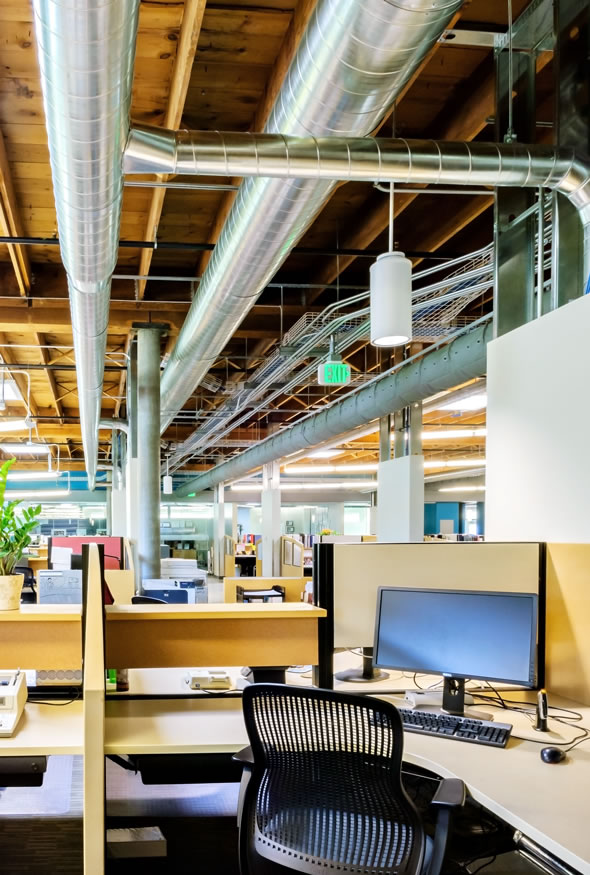Envy the Pacific Northwest. Due to its extensive hydroelectric power generation, the region has remarkably inexpensive energy, and in many locales, geothermal energy—170-degree-Fahrenheit water produced by the Earth’s mantle—is tapped to heat buildings and run steam turbines. The Northwest has used renewable resources for decades.
INSIDE THE DESIGN
Three CSHQA staffers describe the features that make their office tick
Amy Dockter, electrical engineer of record (lighting/power distribution)
“Providing natural light in the space enlivens the environment. Task lighting is provided at each desk to supplement the lighting at night and on overcast days. Daylighting and bright areas are great for mood and when performing written tasks, but less lighting is typically needed, and preferred, for those with computer-in- tensive tasks. We tried to analyze the different areas of the building and locate employees in the areas most conducive to their tasks.”
Russ Pratt, lead mechanical engineer
“The geothermal heating system is not much different from a well-designed boiler system. There are no pipes open to the atmosphere so we don’t smell it or see any rise in humidity. The brazed plate heat exchanger is about the size of a briefcase—versus a boiler 50 times larger—so it doesn’t take up much space in the mechanical room.”
Danielle Weaver, architect and project coordinator
“We have many sustainable features- such as secure bike storage, recycle bins at each desk, showers, and locker rooms. Our central downtown location also allows employees to walk to work or use public transit. We also redesigned our existing cubicles to provide a more open feel throughout the office, which naturally lends itself to collaboration. I really feel like I am part of a cohesive unit with the absence of barriers.”
Boise-based architecture firm CSHQA is worthy of at least as much envy. Regardless of the low-cost energy available in Idaho, president Kent Hanway and his entire team decided to go all-in on sustainability for their new offices. “It’s important for our company to be a leader, to walk the talk,” says Hanway, whose firm designed its first sustainable school building in the 1970s.
Located in Boise’s city center, the building is an adaptive reuse of a 60-year-old warehouse. Drawing from the municipal geothermal system, it channels water through 5/8-inch tubes embedded throughout the single-story structure’s concrete floor. In warmer months, this radiant floor system switches over to cool municipal water. Overhead, cloth ducts with small vents spaced every eight inches maintain ventilation without the pronounced drafts that occur with metal ductwork.
Also overhead and along perimeter walls are skylights and windows that provide diffused light; electric lights automatically dim when natural light strengthens. This is a sustainable and healthier approach that even manages the tricky nature of the sun’s path throughout the course of a day. Design staff can manually adjust desk lighting as needed, and because the building had a freight-loading zone in its previous life, the canopy that once shielded trucks from rain and snow was retained to block afternoon sun, reducing both glare and heat gain.
Where the designers got particularly inventive was in developing a heat-capture system off their desktop computers. The computer exhaust fans are shrouded, connected to a two-inch-diameter conduit that feeds a six-inch spine that runs between adjacent cubicles. In winter, the heat flows through an exchanger to warm incoming air, and in summer, it is sent outside.
This building is only the second in Boise to seek LEED Platinum certification, but “there are many more LEED buildings in development,” says John Maulin, CSHQA’s executive vice president and director. “Even with our lower energy costs, a long-term owner can see a favorable ROI.” Other green features include LED fixtures, sustainable landscaping, and an efficient building envelope.


